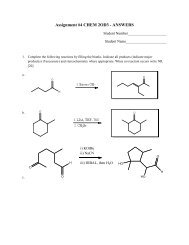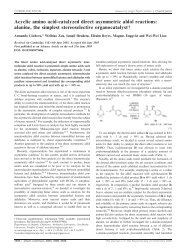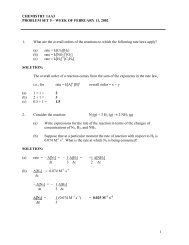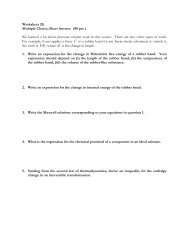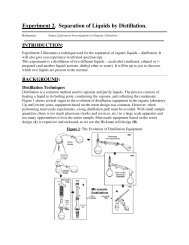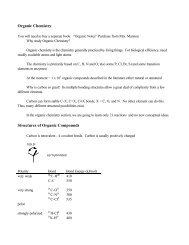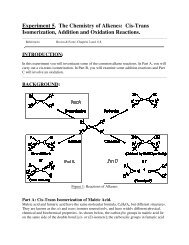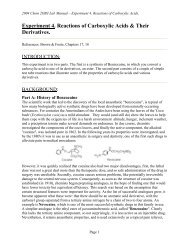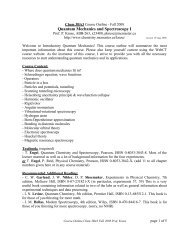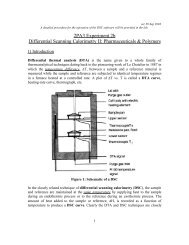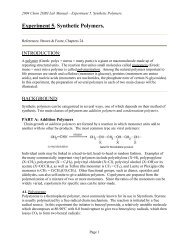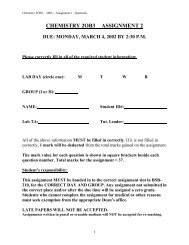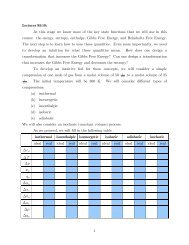(TLC) and
(TLC) and
(TLC) and
You also want an ePaper? Increase the reach of your titles
YUMPU automatically turns print PDFs into web optimized ePapers that Google loves.
Solvent/Solution Mol. Wt.<br />
(g/mol)<br />
Acetic Acid<br />
Ethyl Acetate<br />
Hexane<br />
Methanol<br />
Toluene<br />
60.05<br />
88.10<br />
86.17<br />
32.04<br />
92.14<br />
Safety Data<br />
Irritating to eyes <strong>and</strong> skin. Harmful if swallowed.<br />
Irritating to eyes. Highly flammable.<br />
Highly flammable. Irritating to eyes. Harmful by inhalation.<br />
Highly Flammable. Toxic by inhalation, in contact with skin<br />
<strong>and</strong> if swallowed.<br />
Highly Flammable. Harmful by inhalation.<br />
1. Preparation of the Developing Chamber<br />
Using the chromatography jar provided, place 3-4 mL of the solvent mixture (which is also<br />
provided to you) in the chromatography jar, cover tightly <strong>and</strong> allow to st<strong>and</strong> 5 - 10 minutes<br />
before using. CHROMATOGRAPHY JARS SHOULD BE FILLED IN THE FUMEHOOD<br />
AND STAY IN THERE UNTIL DISPOSAL TIME (Note: Dispose of solvent in the “Organic<br />
Waste” container). The developing solvent system that was provided is a mixture of:<br />
74 mL ethyl acetate<br />
25 mL hexane<br />
1 mL acetic acid<br />
*When finished with the lab empty the jar into the waste, DO NOT WASH JAR with water,<br />
simply leave upside down where you obtained it<br />
2. Preparation of the Sample<br />
a) Obtain an unknown sample from your TA<br />
b) Write down the number of your unknown sample, then remove the label from your vial <strong>and</strong><br />
stick it onto your 10 mL erlenmeyer flask.<br />
c) Dissolve your unknown in 4 mL of methanol-toluene (1:1) in your 10 mL Erlenmeyer flask.<br />
[NOTE: some insoluble material will not dissolve. This is normal.]<br />
FYI: The reference st<strong>and</strong>ards have been prepared at a strength of 25 mg/mL.<br />
3. Application of the Samples<br />
a) Obtain 2 of the commercially prepared fluorescent Silica Gel <strong>TLC</strong> plates provided.<br />
b) To know where your spots started, draw LIGHTLY in pencil a horizontal line 1 cm from the<br />
bottom of the <strong>TLC</strong> plate. If you push too hard, you will crack the silica.<br />
c) You will have five solutions (4 reference compounds <strong>and</strong> 1 unknown) to examine. They<br />
should be spotted on the coated side (not smooth) on the line 1 cm from one end of the sheet,<br />
equally spaced apart, with the outer two spots about 0.75 cm from the edge of the sheet. The<br />
unknown should be placed in the centre, with one reference compound on each side. You should<br />
use two <strong>TLC</strong> plates. You should use one plate to run your unknown plus two of the reference<br />
samples, <strong>and</strong> the other plate to run the unknown plus the remaining two reference samples.<br />
To apply a sample, touch one end of an applicator capillary tube to the solution, <strong>and</strong> then gently<br />
<strong>and</strong> quickly touch the Silica Gel plate at the proper spot. It is important to touch the plate very<br />
lightly <strong>and</strong> not to gouge a hole in the absorbent on the plate. It is also important to touch the plate<br />
very briefly so that the entire contents of the capillary tube is not transfer to the plate. Use the



